Archive Gallery: In Defense of Evolutionary Theory
How we covered the Scopes Monkey Trial, the discovery of Java Man, the Piltdown Man hoax, and milestones in the history of evolutionary theory
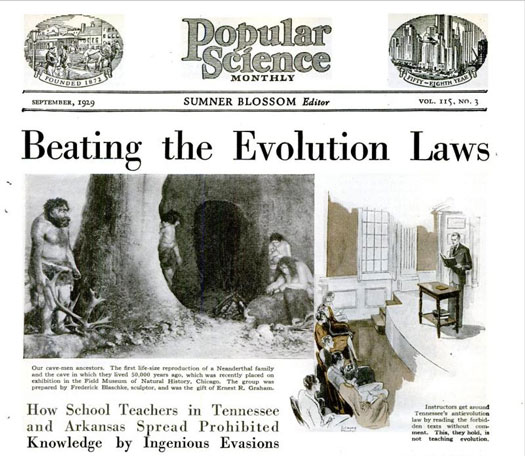
In all our years of covering science, no issue has invited controversy like evolution, and that includes the debate on climate change and whether we’ll ever own flying cars. As a magazine that had been Team Darwin since its founding in 1872, (just 13 years after Darwin wrote On the Origin of Species), we made it a point to publish periodic in-depth features defending evolution as a credible explanation for the origin of life.
We begin in 1923, when Dr. E.E. Free published his serial “The Story of Man and His World,” which was essentially a primer on evolutionary processes. In his essay on our “monkey ancestry,” Free discussed how human and primates descended from a common ape-like ancestor before branching into our respective species. According to Free’s studies, mankind descended from lemur-monkeys that migrated to Asia from Central America. Over millions of years, he eventually moved down from the trees and onto the ground, where he learned to handle tools.
Free’s ideas took a turn for the outrageous six years later, when he proposed that “cosmic rays” (or high-energy photons) accelerated evolution while passing through Earth’s atmosphere. Although this idea was less popular than his other contributions to our magazine, which meticulously examined the physical traits humans share with other animals, Free’s ideas nonetheless reflected the public’s thirst for answers on how life began.
From then on, much of our coverage on evolution has dealt with historical milestones: the Scopes Monkey Trial, the discovery of “Mrs. Ples,” the resurgence of the coelacanth, and the Piltdown hoax, all received ample (and exuberant) coverage on our pages. We even published a story on how instructors quietly circumvented anti-evolution laws to educate students Darwin’s ideas.

By the late 1920s, the scientific community embraced Charles Darwin’s theory of evolution as fact. Although much of the public had warmed up to his ideas, it had yet to achieve national acceptance, as evidenced by the Scopes trial that would occur two years after this article’s publication. To educate our readers on the origin of species, we published Dr. E.E. Free’s serial “The Story of Man and His World.”
The fourth article in the series, pictured left, explained how primitive beings evolved into modern-day mankind. “Man was not created suddenly out of nothing either in Eden or elsewhere nor on any definite date,” Free wrote, so where did he originate? While examining our ancestry, where do we draw the line between animal and human? Free explained that 70 to 80 million years ago, catlike creatures skipped about in the North Pole before migrating down to North America, and then to Central America, where they evolved into lemurs. Eventually, the lemur-monkeys moved down to Asia, where they grew stronger, moved from the trees to the ground, and became ape-like half-walkers, which in turn evolved to an a “man-ape” called Pithecanthropus erectus (homo erectus erectus), also known as Java Man. Need proof? Examine your own body and note the similarity of its structure to the make of a primate’s, Free said. While he went on to name Pithecanthropus as the possible missing link between modern humans and the common ancestor we share with apes, anthropologists today believe that humans descended from homo erectus rather than Java Man.
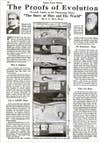
In this edition of “The Story of Man and His World,” Free explained why evolution is a credible theory. Since fossils demonstrate how Earth’s species have changed over the years, there’s no reason to believe that they sporadically appeared fully-formed via supernatural events. Second, the human body contains several leftover relics from primitive ancestors, such as the tailbone and the appendix. Neither of these structures serve a real purpose to us today. You can also see how parts of the human body, like our fingernails and our spines, were inherited by animals that came before us. If you experience difficulty imagining how human beings evolved from worm and fish-like creatures, consider how a human fetus develops from a tadpole-shaped creature to a baby within nine months. Finally, Free pointed out, artificial breeding shows how evolution works on a smaller scale.
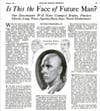
Sir Arthur Keith, author of A New Theory of Human Evolution became famous for his contributions to the theory of group selection. In his book, Keith proposed that mankind evolved by using cultural barriers to create small competing communities, which were in turn determined by racial differences. Naturally, his ideas invited controversy in discussions about nationalism and race, but this was nothing new for Keith; a couple of decades before the book’s publication, he proposed that man would someday have squashed, pointy features, sparse hair, and small brains. Essentially, we would resemble “water-blooded, ‘esthetic,’ meagerly nourished morons.”
Although scientists argued that mankind had reached its final evolutionary stage, Keith maintained that if we’d been evolving for millions of years, there was no reason why we’d stop now. After examining hundreds of skulls dating back to 500,000 B.C., and measuring the heads of living persons, Keith concluded that the further we moved from our past as hunter-gatherers, the more our features would adapt to civilized society. Consider how small our jawlines are compared to the jawlines on human fossils. While a prominent jaw helped them chow down wild animals, our use of utensils while eating has rendered that strong jaw unnecessary.

In May 1925, high school biology teacher John T. Scopes was accused of breaking the Tennessee’s Butler Act by teaching evolution from a textbook. This of course led to the highly-publicized State of Tennesse v. Scopes case, also known as The Scopes Monkey Trial. Four years after Scopes’ guilty verdict was overturned, we revisited the event by doing a write-up on how other instructors were circumventing restrictions against teaching evolution. Writer Orland Kay Armstrong toured the “antievolution belt” to find that many professionals (even active church members) were bent on educating their students on Darwin’s theories without getting caught. Since the anti-evolution law in Arkansas only specifically banned the theory that mankind descended from primitive creatures, one science teacher from Arkansas would teach the evolution of plants and animals, in hope that his students would conclude that mankind had also evolved from single-celled organisms. Another teacher would talk about Darwin’s theories without commenting on them, while others would refer their students to library books about evolution without presenting their content in class. Teachers weren’t the only ones who acted sneakily, though. Since the law in Arkansas didn’t prevent people from ordering books on evolution from another state, some students would take the initiative to buy these books and educate themselves.
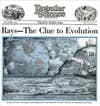
Despite defending evolutionary theory in “The Story of Man and His World,” Dr. E.E. Free spent many years feeling stumped at how the process began in the first place. Six years after the serial’s publication, he encountered what he believed was the answer, which he published in a followup article for our magazine. He theorized that “cosmic rays,” then considered high-energy photons, accelerated evolutionary processes by generating mutations. Free’s ideas stemmed from theories by Robert A. Millikan, an experimental physicist who believed that these cosmic ray photos were the “birth cries” of new atoms created by God to prevent “heat death of the universe.” Free also cited experiments by Professor H.J. Muller, from the University of Texas, who found that exposing fruit flies to X-Rays prompted them to produce new types of offspring. He posited that like radium and X-rays, cosmic rays (later discovered to be highly-charged particles instead of high-energy photons), could influence the rate of evolution according to their level of intensity.

If man evolved from fish and mammal-like reptiles, where did we get our faces? This is the question writer Michael Mok asked Dr. William King Gregory, American zoologist and expert on comparative anatomy. “You got your face from a fish,” Gregory answered. “In fact, you got it from a shark.”
Here’s how you can trace it back, he explained: our common ancestor got his face from a monkey, the monkey got it from an opossum, who got it from a lizard, who got it from a fish. Every successive species added a feature to the face until it had evolved into the human one we’re familiar with today. If you compare the faces of a man and a fish, you’ll notice that they aren’t all that different structurally; both have noses and mouths in front of our smelling parts. Both man and fish have jaws below their eyes. Both have teeth. Such similarities aren’t coincidental, but rather, indicative of how species adapt and evolve over time.

After explaining how man had derived his face from a fish, Dr. Gregory went on to outline how homo sapiens sapiens descended from apelike ancestors. While it’s easy for laymen to simply look up the information in an encyclopedia, it can take researchers years to agree on whether scattered bone fragments came from a human ancestor or from an ape. Take a look at the chart on the left, where Piltdown man is erroneously labeled as an eminent ancestor of mankind (more on that later). Ironically, while discussing how scientists debated the legitimacy of Java Man, Gregory referenced Piltdown man as a solid example of of a verified human ancestor.
Obviously, our ancestors differed from us in appearance and in speaking ability, but what sets humans apart from primitive man is our propensity for reasoning, social obligations, and conscious brutality. Primitive man is often depicted with a furrowed brow and a club in one hand, but Gregory was convinced that our ancestors weren’t capable of evil. “The manlike apes are models of innocence and without guile, for the simple reason that they haven’t brains enough to be wicked,” he said.
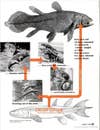
In 1938, fisherman off the cost of South Africa reeled in a species of fish believed to have been extinct since the late Cretaceous period, which took place 65 million years ago. Scientists called the coelacanth a “living fossil” since they had discovered its bones prior to finding a living specimen. Researchers hailed the coelacanth’s resurgence as the most important event in the study of natural history during the 20th century. Access to a live specimen allowed researchers to study the internal organs of the “prehistoric” creature, which in turn could improve their understanding of how fish in the coelecanth’s family developed limb-like fins.

In 1924, Australian anatomist and anthropologist Raymond A. Dart discovered the first fossil found of Australopithecus africanus, an extinct hominid thought to have been a distant ancestor of human beings. For 20 years, the scientific community rejected Dart’s findings, but support from fellow South African paleontologist Robert Broom led to the fossil’s eventual acceptance, especially after Broom discovered more varieties of Australopithecines. This article gave the whole saga a narrative, describing how Broom’s young coworkers fervently sifted through piles of rock to find hominid fossils among the collections of antelope, monkey, and baboon bones. In 1947, Broom and John T. Robinson found “Mrs. Ples,” the most complete skull of Australopithecus africanus ever discovered, thus lending the species more credibility in the scientific community.

And now we arrive at the “Piltdown Man” hoax, where bone fragments were pieced together and presented as if they belonged to an early hominid. For more than 40 years, Piltdown Man was considered by many as the “missing link” between apes and man, only to be exposed as a fraud in 1953 when Time published a feature outlining how the skull came from three different species: a human, an orangutan, and a chimpanzee.
How exactly did Piltdown Man remain a hoax for so long? Prior to the exposé, several scientists expressed their skepticism since chemical tests dated the remains at 50,000 years instead of half a million. Moreover, tests on the molars suggested that the teeth had been filed, which in turn led scientists to conclude that someone had deliberately forged the skull instead of mistakenly identified it. To this day, the identity of the forger remains unknown, although historians suspect Charles Dawson (who discovered the remains), Arthur Keith, and Arthur Conan Doyle, among other prominent figures.